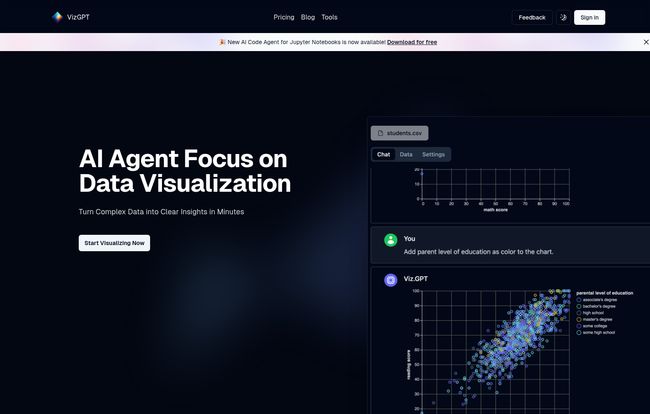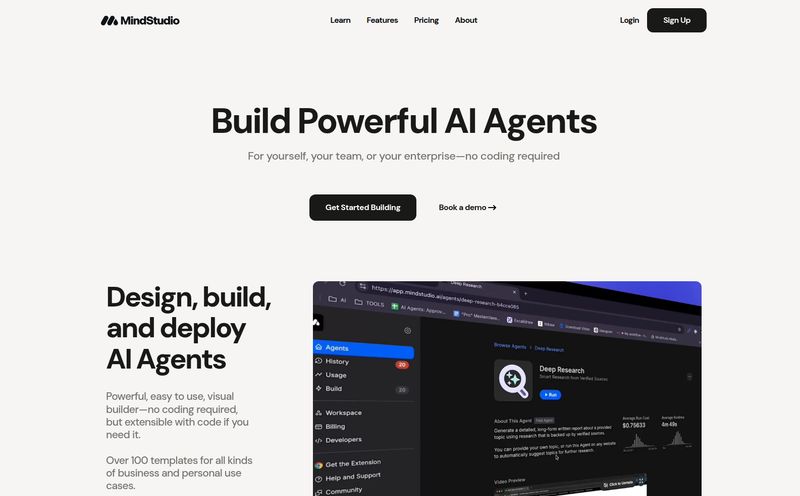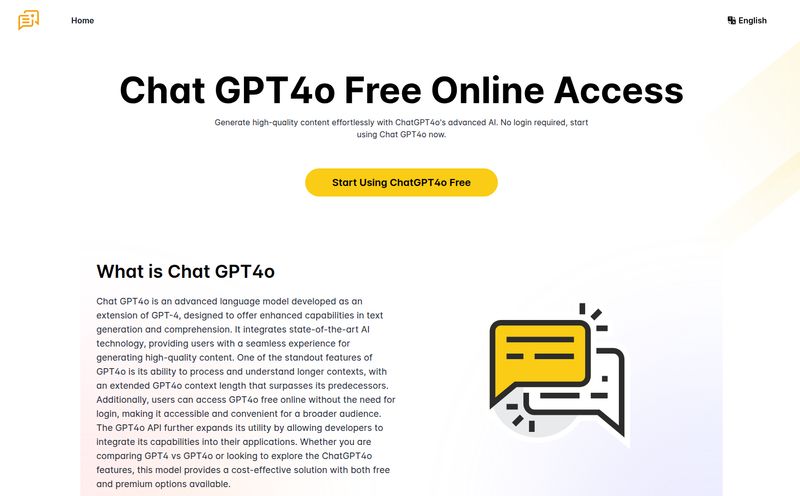We've all been there. You've got a spreadsheet brimming with juicy data, and you know there's a story hidden in those rows and columns. But to tell that story visually? Ugh. You're suddenly wrestling with pivot tables, trying to remember the right formula in Google Sheets, or clicking through a dozen menus in a legacy BI tool just to make a simple bar chart. It feels less like analysis and more like digital plumbing.
For years, the dream has been simple: what if I could just ask my data questions? In plain English? No code, no clunky interfaces, just a conversation.
Well, the AI wave is trying to make that dream a reality, and a new tool called VizGPT has landed on my radar. It claims to be an “AI Agent Focus on Data Visualization,” letting you generate charts just by chatting with it. My inner SEO and data nerd perked up immediately. Is this another overhyped AI toy, or is it a genuinely useful tool that could change how we work with data? I had to find out.

Visit vizGPT
So, What is VizGPT, Actually?
Forget the marketing jargon for a minute. At its core, VizGPT is a translator. It translates your normal, everyday questions into a language that data understands, and then it presents the answer as a visual chart or graph. You upload a dataset (like a CSV file), and then you just start talking to it. “Show me sales by region,” or “create a scatter plot of user age vs. time spent on site,” and poof, a chart appears.
But here’s the bit that really got my attention. It’s not just a one-and-done command prompt. VizGPT has a memory. It understands context. This is the secret sauce, in my opinion.
The Real Magic is in the Conversation
I’ve tested a few “AI chart generators” before, and they often feel like a magic trick that only works once. You type in a long, perfectly crafted prompt, and it gives you a chart. But if you want to change one tiny thing? Like, say, change the color of the bars or filter out a specific country? You have to write a whole new, complex prompt from scratch. It’s frustrating.
VizGPT is different. It’s designed to be iterative. Here's a taste of a real workflow I tried:
- Me: “Create a bar chart showing the average horsepower by country of origin.”
- VizGPT creates the chart. It's okay, but a bit basic.
- Me: “Okay, now sort it from highest to lowest.”
- The chart reorders itself. Nice.
- Me: “Hmm, change the color of the ‘USA’ bar to blue.”
- Done. The single bar changes color.
- Me: “Actually, a horizontal bar chart might look better.”
- The chart flips orientation instantly.
See what happened there? I had a conversation. I didn't need to repeat my entire request every time. The AI remembered the context of what we were building together. This feels less like a tool and more like having a junior data analyst on hand who, you know, actually listens to feedback. It’s this contextual understanding that moves it from a novelty to a genuine productivity booster.
Not Just Talk: A Look Under the Hood
While the chat interface is the star of the show, VizGPT isn’t a one-trick pony. It has some surprising depth once you start poking around.
Natural Language is Your New Superpower
This is the main draw. It dramatically lowers the barrier to entry for data analysis. Marketers, small business owners, product managers—anyone who isn’t a full-time data scientist—can start getting answers from their data immediately. You don't need to learn SQL or DAX; you just need to know how to ask a question. This is a huge democratization of data.
The Familiar Comfort of Drag-and-Drop
But what if you’re a power user? What if you know exactly what you want and find typing out sentences to be slower than just… doing it? VizGPT has you covered. It includes a more traditional drag-and-drop interface, very similar to what you'd find in Tableau or Power BI. You can drag your data fields into ‘X-Axis,’ ‘Y-Axis,’ and ‘Color’ buckets. I love this. It shows they understand their audience. They're not forcing you into one workflow; they're giving you options.
More Than Just Pretty Pictures
The tool also includes a “Powerful Intelligent Data Table.” This isn’t just a simple spreadsheet view. It helps with data profiling, giving you a quick overview of your data's health—things like value distribution, missing data, and basic stats for each column. This is a crucial first step in any real data project, and having it built-in saves a ton of time. You can perform data transformations right there, cleaning things up before you even start visualizing.
Let’s Talk Money: VizGPT Pricing
Okay, this is often where the dream dies. A cool new tool comes along and then hits you with a soul-crushing enterprise-only price tag. I was pleasantly surprised here. VizGPT’s pricing is refreshingly straightforward.
| Plan | Price | Key Features |
|---|---|---|
| Professional | $10 / month | Advanced visualization with GPT-4, priority AI processing, unlimited data sources, premium support. |
| Enterprise | Custom | Custom development, dedicated support, on-premises deployment, API integration, advanced security. |
Honestly, $10 a month for the Professional plan is a steal. For context, a single license for a major BI tool can run you many times that. For an individual, a freelancer, or a small team, this price is a no-brainer. Plus, they offer a 7-day free trial, so you can test it out with your own data without any commitment.
The Other Side of the Coin
No tool is perfect, right? Based on my experience and looking at the common debates around AI tools, there are a couple of things to keep in mind.
First, the reliance on AI can sometimes feel like a “black box.” For 90% of tasks, it’s amazing. But for that last 10% where you need pixel-perfect, granular control over some obscure chart element, you might feel a bit limited compared to a traditional, manual tool. The drag-and-drop interface helps mitigate this, but it’s still a trade-off between speed and absolute control.
Second, while I think the price is great, for some users like students or those in developing countries, any subscription can be a barrier. It’s not free, and that’s a factor. But again, compared to the market, it's extremly competitive.
My Final Verdict: Is VizGPT Worth Your Time?
Yes. Unreservedly, yes. VizGPT isn't just another AI gimmick. It’s a well-designed, thoughtful tool that solves a real, nagging problem for a huge number of people. It makes data analysis more accessible, faster, and frankly, a lot more fun.
It strikes a brilliant balance. It's simple enough for a total beginner to get instant value, but it has enough depth with its drag-and-drop interface and data-profiling tools to be useful for seasoned analysts looking to speed up their exploratory work. The conversational, iterative approach is the real winner here. It’s how data analysis should feel.
If you've ever looked at a spreadsheet and wished you could just talk to it, you owe it to yourself to give VizGPT’s free trial a spin.
Frequently Asked Questions
- Do I need to know how to code to use VizGPT?
- Absolutely not! The whole point is to use natural language—plain English—to create your visualizations. If you can ask a question, you can use VizGPT.
- How does VizGPT compare to tools like Tableau or Power BI?
- Think of VizGPT as a super-fast and easy-to-use tool for exploratory data analysis and chart creation. Tableau and Power BI are more like heavy-duty, end-to-end business intelligence platforms with complex data modeling and dashboarding features. VizGPT is about getting answers quickly; they are about building complex, permanent reports. They can even complement each other.
- Can VizGPT handle large datasets?
- For a web-based tool, it performs quite well with reasonably sized datasets (like typical CSV files). For massive, gigabyte-scale enterprise data warehouses, you’d still want to use a dedicated BI tool. But for most everyday analysis, it's more than capable.
- What kind of charts can I create?
- You can create all the standard charts you'd expect: bar charts, line graphs, pie charts, scatter plots, area charts, histograms, and more. The key is to just ask for what you want, like “show me a pie chart of…”
- Is my data secure with VizGPT?
- This is always a critical question for cloud-based tools. According to their site, they take security seriously, and the Enterprise plan offers advanced security compliance and even on-premises deployment for maximum control. As always, you should review the privacy policy of any tool you upload sensitive data to.



